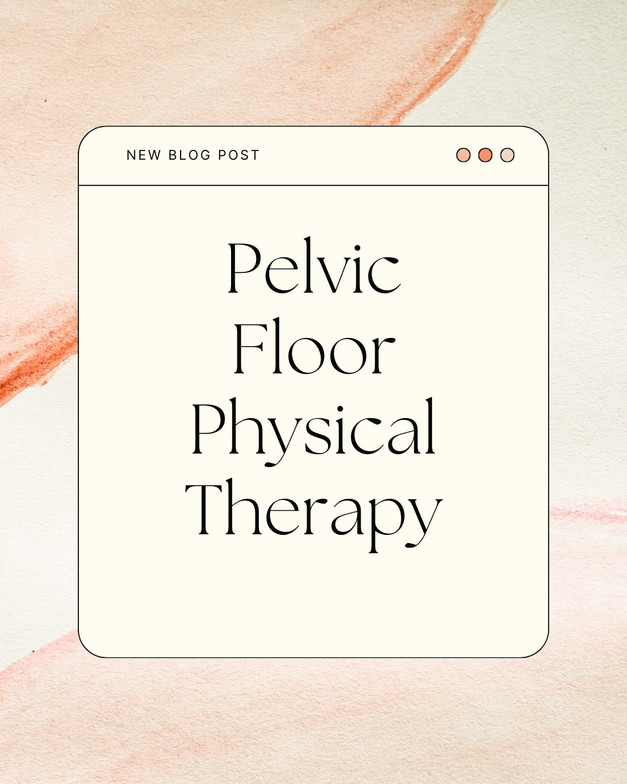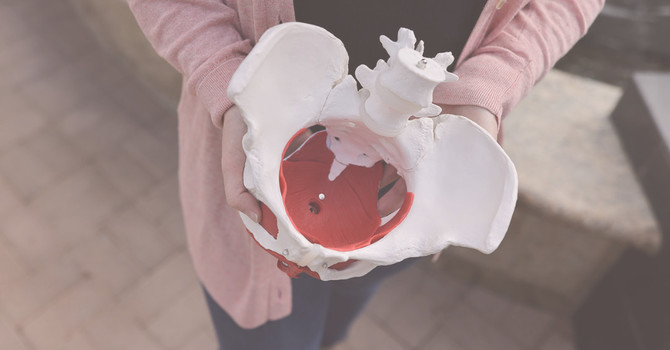
What is Pelvic Floor Physical Therapy and Why is It Beneficial?
If you've recently heard the term "pelvic floor physical therapy" and are wondering what it’s all about, you’re not alone. The pelvic floor is really having its spotlight moment recently.. yay! The pelvic floor is a part of your body that plays a big role in your overall health, but it’s not something most people think about every day. As a pelvic floor physical therapist, I’m here to explain what pelvic floor physical therapy is, why it matters, and how it can make a difference in your life.
Understanding the Pelvic Floor
The pelvic floor refers to a group of muscles, ligaments, and connective tissues that form a supportive hammock at the base of your pelvis. These muscles play a key role in controlling important functions, including:
- Bladder and bowel control: Helping to manage urinary and bowel movements.
- Sexual function: Contributing to sensations and comfort during intimacy.
- Postural support: Working in tandem with your core to provide stability to your spine and pelvis.
- Childbirth: In women, the pelvic floor muscles stretch and strengthen during pregnancy and delivery.
The pelvic floor is involved in many daily activities, yet most of us rarely give it much thought—until something isn’t working quite right.
What is Pelvic Floor Physical Therapy?
Pelvic floor physical therapy is a specialized type of physical therapy that focuses on the muscles, tissues, and functions of the pelvic region. But pelvic floor physical therapy goes beyond just the pelvis, especially being that so many other factors can influence the pelvic floor (i.e. nutrition, hydration, activity level, stress levels, etc). It’s important to address you as a person, not just your diagnosis.
If you're experiencing any symptoms related to pelvic floor dysfunction—such as incontinence, pelvic pain, or difficulty with sexual health—pelvic floor physical therapy can help.
Why Is Pelvic Floor Physical Therapy Beneficial?
Pelvic floor physical therapy offers a variety of benefits for people of all genders and ages. Here are a few reasons why it might be the right choice for you:
- Restoring Function and Comfort: Whether you're dealing with urinary leakage, constipation, or pelvic pain, pelvic floor therapy helps restore normal function and alleviate discomfort. Through progressive exercises and techniques, therapists guide you in strengthening or relaxing the muscles of the pelvic floor to improve symptoms.
- Non-Invasive Treatment: Pelvic floor physical therapy is a non-surgical, non-pharmaceutical treatment. For many people, it can provide relief without the need for medication or invasive procedures. It’s a great option for those who want to avoid surgery or are seeking an alternative to medication.
- Improving Quality of Life: Pelvic floor issues can impact many areas of life, from intimacy to social situations. Symptoms like leakage or pain can be isolating, but physical therapy helps to improve these challenges, giving you the tools to regain control over your body and feel more confident in your everyday activities.
- Prevention and Education: Even if you're not experiencing symptoms, pelvic floor physical therapy can help prevent future issues. Through education about proper posture, core strengthening, and body mechanics, therapists teach you how to protect your pelvic floor and avoid strain. This can be especially helpful during pregnancy, postpartum recovery, or aging.
- Personalized Care: Every body is different. Pelvic floor physical therapy is highly individualized, meaning your treatment plan will be tailored to your unique needs. Whether you're experiencing postnatal challenges or struggling with pelvic pain, your therapist will work with you to create a plan that makes sense for your goals and concerns.
What Can You Expect in a Pelvic Floor PT Session?
I always tell my patients from day one, “this is a safe space.” Discussing topics of pelvic floor concerns can sometimes be sensitive, but know that you will always be met with support and genuine care for you and your story. In our evaluation, I will ask you about your medical history, current symptoms and what your goals are. No topic is off-limits and no goal is too lofty. I will do an assessment of your movement quality, strength and mobility. With the information collected, we will then collaborate on a treatment plan that may include the following:
- Exercises: You can always expect to have some form of exercise when it comes to pelvic floor physical therapy. These will not only include pelvic floor coordination focused, but also the holistic approach of strengthening the body top to bottom.
- Manual Therapies: I personally utilize a variety of hands-on therapy including soft tissue mobilization, dry needling, myofascial decompression/cupping, and more. All of which can be beneficial to your progress.
- Education: I am 100% going to educate you on all things pelvic floor. Starting from the anatomy and function, to how we can support our pelvic floor through different habits, you will definitely feel empowered after learning more about your body.
Who Can Benefit from Pelvic Floor Physical Therapy?
Pelvic floor issues can affect anyone, regardless of age, gender, or stage of life. Common reasons people seek pelvic floor physical therapy include:
- Pregnancy and Postpartum: Pelvic floor therapy helps prepare for childbirth and supports recovery after delivery. It’s common to experience pelvic pain, incontinence, or prolapse after giving birth, and physical therapy can assist with rehabilitation.
- Urinary Incontinence: If you struggle with bladder leakage—whether during exercise, coughing, or sneezing—pelvic floor therapy can help strengthen the muscles involved in bladder control.
- Chronic Pelvic Pain: Conditions like pelvic organ prolapse, endometriosis, and interstitial cystitis can cause significant discomfort. A therapist can guide you through techniques to reduce pain and improve function.
All in all...
Pelvic floor physical therapy isn’t as scary as some may think it is. I believe in meeting you where you are, and that pelvic floor physical therapy is a valuable resource for anyone looking to maintain pelvic health and prevent future issues. Whether you’re recovering from childbirth, experiencing pelvic pain, or simply want to learn how to care for your pelvic floor, pelvic floor physical therapy can help.
If you're curious about how pelvic floor physical therapy can help you, don't hesitate to reach out. Taking care of your pelvic health is a powerful way to feel better in your body and improve your quality of life. Remember, it’s never too late to start! Your pelvic floor is a key part of your overall well-being, and getting the right support can make a world of difference.

Lauren Cairo
Contact Me

.jpg)
